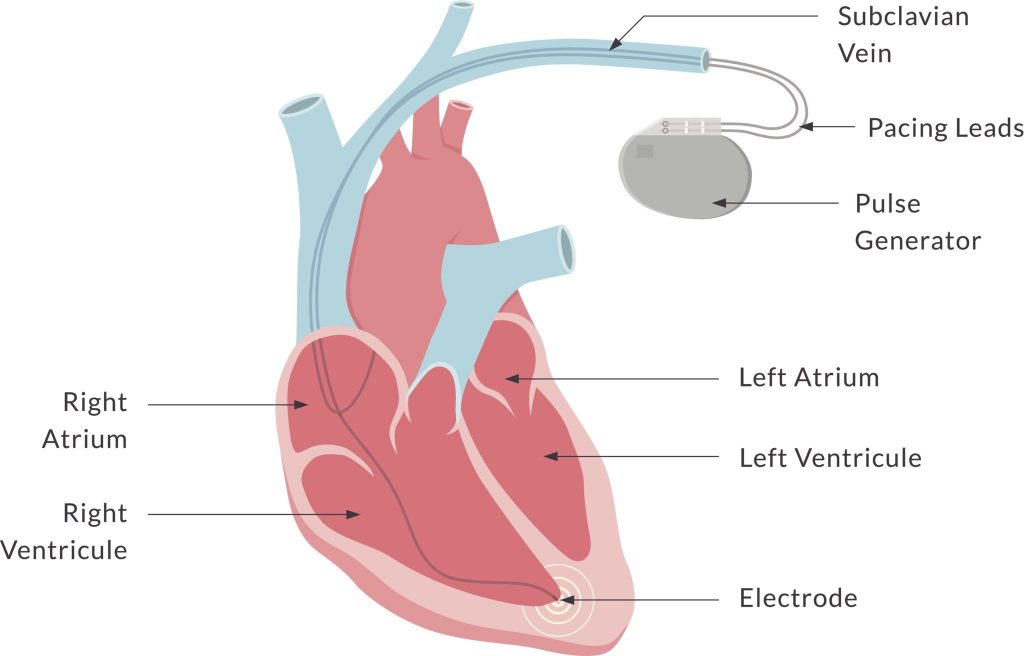Mark Kopec Now
Pacemaker
💔 Medical Malpractice and the Pacemaker: When a Lifesaving Device Leads to Legal Claim
The implantation of a pacemaker is a common, often life-saving medical procedure. These small, sophisticated devices regulate the heart’s rhythm. They provide critical support to patients suffering from bradycardia (slow heart rate) or other debilitating electrical conduction disorders. The complexity of the diagnosis, recommendation, and implantation process of a pacemaker means that potential for medical malpractice—exists at multiple stages. These include from initial patient assessment to surgical placement.
🕰️ A Brief History of Cardiac Pacing
The concept of electrically stimulating the heart has roots in the 19th century. However, the modern era of pacing began in the mid-20th century. Early devices were bulky and externally powered. Engineer Wilson Greatbatch developed the first fully transistorized, body-implantable pacemaker. He successfully implanted it in 1960. Since then, technological advancements have led to smaller, longer-lasting, rate-responsive, and now even leadless devices. These have revolutionized the treatment of cardiac rhythm abnormalities and extending the lives of millions worldwide. This history of rapid technological progress means that medical providers are continually responsible for keeping up with the current standard of care regarding device selection.
🫀 Relevant Cardiac Anatomy and Function
To understand a pacemaker, one must first grasp the basic electrical system of the heart.
The Heart’s Natural Conduction System
The heart muscle (myocardium) contracts rhythmically. It drives by an electrical impulse that begins in the sinoatrial (SA) node, often called the heart’s natural pacemaker. This is located in the upper wall of the right atrium.
- The impulse travels across the atria, causing them to contract.
- It reaches the atrioventricular (AV) node, which acts as a gateway, slowing the impulse slightly.
- The impulse then rapidly travels down the Bundle of His. Then it goes through the Purkinje fibers into the ventricles. This causes them to contract and pump blood to the body and lungs.
A normal, healthy heart rhythm (sinus rhythm) follows this precise pathway.

What the Pacemaker Does and How It Works
A modern pacemaker has two main components:
- Pulse Generator: A small metal casing containing a battery and sophisticated computer circuitry. This unit monitors the heart’s electrical activity.
- Leads (Electrodes): Insulated wires that run from the pulse generator (typically implanted just beneath the collarbone) to the heart chambers.
The device’s function is “demand pacing”: it only activates when the heart rate drops below a pre-set threshold or when it detects a pause in the heart rhythm.
- The leads sense the heart’s intrinsic electrical activity.
- If the activity is too slow or absent, the pulse generator delivers a tiny, timed electrical impulse through the lead to the heart muscle, stimulating a contraction.
- Pacing can be single-chamber (pacing one chamber, usually the right ventricle), dual-chamber (pacing the right atrium and right ventricle), or biventricular (for cardiac resynchronization therapy).
The Kopec Law Firm can assess your heart history and the need for a pacemaker, to advise you on a potential medical malpractice claim.
What a Pacemaker Can’t Do
Crucially, a pacemaker is an electrical device; it cannot address mechanical or structural issues.
- It cannot unclog blocked arteries: It does not treat coronary artery disease (CAD).
- It cannot strengthen weak heart muscle: While it can improve efficiency in some cases of heart failure (CRT), it does not cure the underlying cardiomyopathy.
- It cannot treat all arrhythmias: It is primarily for bradyarrhythmias (slow rhythms). It is generally not used to treat fast, chaotic rhythms (tachyarrhythmias) like ventricular fibrillation, which requires an Implantable Cardioverter-Defibrillator (ICD). Malpractice can arise from implanting the wrong device (e.g., a pacemaker when the patient needs an ICD).
The key functional difference lies in their primary purpose:
- Pacemaker: Provides low-energy, timed electrical pulses to pace a heart that is beating too slowly or has paused, ensuring it maintains a minimum rate (bradycardia treatment).
- Implantable Cardioverter-Defibrillator (ICD): This device is to defibrillate or cardiovert a heart experiencing dangerously fast and chaotic rhythms (tachyarrhythmias). It contains all the features of a standard pacemaker, but it can also deliver a high-energy electrical shock to instantly reset the heart’s electrical system and restore a normal rhythm.
Because an ICD is necessary for patients at high risk of sudden cardiac arrest death from ventricular fibrillation, implanting a basic pacemaker instead of an ICD can form the basis of a significant medical malpractice claim.
🩺 Indications and Providers: The Pre-Implantation Stage
Symptoms and Medical Conditions Warranting a Pacemaker
A pacemaker is generally recommended for patients experiencing symptomatic bradycardia. Common symptoms include:
- Syncope (fainting) or near-syncope
- Severe dizziness or lightheadedness
- Profound fatigue and weakness
- Shortness of breath
Conditions that often necessitate pacing include:
- Sick Sinus Syndrome (SSS): The SA node fires too slowly or erratically.
- Advanced Atrioventricular (AV) Block (2nd or 3rd degree): The electrical signal is delayed or completely blocked between the atria and ventricles.
- Symptomatic Bradycardia following a Myocardial Infarction (heart attack).
- Certain types of heart failure (requiring Cardiac Resynchronization Therapy, or CRT).
Providers Who Assess and Recommend
The assessment begins with a Primary Care Physician (PCP) who notes symptoms and potentially refers the patient to a specialist.
The definitive assessment, diagnosis, and recommendation are typically performed by a Cardiologist, often one specializing in Cardiac Electrophysiology (EP). These providers utilize tools like Electrocardiogram (ECG), Holter monitors, stress tests, and Electrophysiology studies to diagnose the precise nature of the rhythm disorder and determine if the problem is severe enough to warrant a device.
⚖️ Possible Medical Malpractice Claims: Failure to Recommend a Pacemaker
A critical area for malpractice claims is the failure to timely diagnose or recommend a pacemaker when one is medically indicated based on the standard of care. These claims often hinge on a pattern of symptom presentation and EKG results.
Common Scenarios for Failure-to-Recommend Claims:
- Misdiagnosis or Misinterpretation of Diagnostic Tests: The cardiologist fails to recognize signs of a high-grade AV block or severe sinus node dysfunction on an EKG or monitor recording.
- Failure to Act on Alarming Symptoms: A patient presents with recurrent syncope clearly documented to be caused by bradycardia, but the provider delays referral or recommendation, leading to a subsequent fall, injury, or death.
- Failure to Monitor Patients with Known Precursors: A physician fails to appropriately follow a patient with documented, albeit currently asymptomatic, bifascicular block or first-degree AV block that can progress to complete heart block.
- Failure to Update Care Based on Guidelines: The provider recommends monitoring when current professional guidelines (e.g., those from the American College of Cardiology/American Heart Association) recommend device implantation for the patient’s specific condition.
In these cases, the plaintiff must prove that, had the standard of care been followed and the pacemaker recommended and implanted, the patient would have avoided the resulting injury (e.g., subdural hematoma from a syncopal episode or death).
🔪 The Pacemaker Implantation Stage: Providers and Potential Medical Malpractice Claims
Providers Who Implant Pacemakers
Pacemaker implantation is a minor surgical procedure performed in a cath lab or operating room. The procedure is almost exclusively performed by Cardiologists specializing in Electrophysiology (EP) or sometimes by Cardiac Surgeons, though the EP approach is far more common for transvenous lead placement.
Possible Medical Malpractice Claims Arising from Pacemaker Implantation
Once the doctor makes the decision to implant, a new set of risks and potential negligence arises related to the technical performance of the procedure, post-operative care, and device selection.
1. Surgical Error Claims Related to Technical Medical Malpractice During Pacemaker Surgery:
- Lead Placement/Dislodgement: The doctor must secure the leads correctly (e.g., in the right ventricle apex or septum). If the doctor negligently places the lead or manipulates it, it can become dislodged shortly after surgery. This can result in device failure and the need for immediate, emergent re-operation.
- Cardiac Perforation/Tamponade: Negligent maneuvering of the lead during implantation can perforate the heart muscle. This can lead to a potentially fatal condition known as cardiac tamponade (fluid buildup in the pericardial sac). Negligence may occur if the provider fails to use appropriate imaging or technique to minimize risk.
- Vascular/Nerve Injury: Negligently causing injury to nearby blood vessels (subclavian vein, etc.) or nerves during device pocket creation or lead insertion.
2. Medical Malpractice Claims Related to Pacemaker Device Selection and Programming:
- Implanting the Wrong Device: As noted above, implanting a basic pacemaker when the patient needs an ICD for a high risk of sudden cardiac death.
- Negligent Programming: The EP specialist or pacemaker technician negligently programs the device parameters (rate, output, sensitivity) post-implantation. This can lead to device failure to capture, inappropriate sensing, or depletion of the battery, thereby failing to protect the patient.
3. Medical Malpractice Claims Related to Pacemaker Post-Operative Care:
- Failure to Detect Early Complications: Negligence in post-operative monitoring, such as failing to obtain a post-procedure chest X-Ray to check for a pneumothorax (collapsed lung) or lead position, or failing to quickly address signs of infection at the implant site.
Conclusion on Pacemaker Medical Malpractice
The pacemaker remains a modern medical miracle, yet its use is fraught with legal complexity. For a successful medical malpractice claim—whether stemming from the failure to recommend a necessary pacemaker device or negligence during its implantation—a plaintiff must demonstrate a deviation from the accepted standard of care and a direct causal link between that deviation and the resulting patient injury. As heart rhythm disorders continue to affect the population, the medical and legal communities must remain vigilant to uphold the highest standards of care at every phase of pacemaker patient management.
If you have been injured in connection with a pacemaker, contact the Kopec Law Firm.
Visit our free consultation page or video. Then contact the Kopec Law Firm at 800-604-0704 to speak directly with Attorney Mark Kopec. He is a top-rated Baltimore medical malpractice lawyer. The Kopec Law Firm is in Baltimore and pursues cases throughout Maryland and Washington, D.C.





